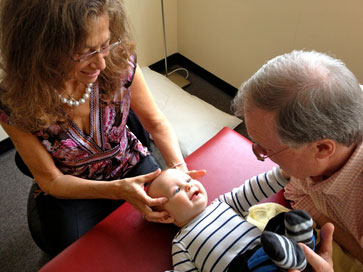Devorah Steinecker, D.O.
Over 30 Years experience as an adult Neurologist with special training in Child Development and Osteopathic Cranial therapy.

Over 30 Years experience as an adult Neurologist with special training in Child Development and Osteopathic Cranial therapy.
Osteopathic Manipulative Therapy (OMT) is a safe, gentle, non-invasive means of re-establishing normal anatomical structure and physiologic function. If an organ, or its corresponding nerve is compressed or damaged, the normal function of the nerve and the end organ is disrupted.
In Osteopathic medicine these anatomic and physiologic considerations become very important. In contrast, the Typical Medical Approach, treats all symptoms as parts of different systems. For example, a child may be dealing with a variety of issues such as: feeding and latch issues, sleep problems, excessive cyring, asthma, strabismus (cross-eyes), ear infections or motor and sensory delays. The child may be sent for evaluation and treatment to many different doctors such as ENT, G.I., Respiratory, or Psychiatry. Those doctors then refer to several different types of therapists (speech and swallowing, biofeedback, feeding specialists, etc.).
Some may order many tests, and/or prescribe medications, when, in many cases the Osteopath is able to identify the SOURCE of the problem, thereby eliminating many of the downstream symptoms that do not seem to be related.


Because of the “blood brain barrier”, brain cells require circulation of the CSF so that all cells can receive nourishment and oxygen. Osteopaths with specialty training in this area (the “cranial field”) work with the bones of the cranium, the fascial coverings (meninges), the fluids, and especially the central nervous system (the brain) to access the whole person, for both treatment of dysfunction and improvement of health. Sometimes called cranial osteopathy, it is an additional set of skills gained by osteopaths to better address the whole body.
The cranial concept, first put forth by W. G. Sutherland, DO and originally alluded to by A.T. Still, MD, involves the application of Dr. Still’s principles of Osteopathy to the head (cranium) and to the tailbone (sacrum). It is based on The Five Components of the Primary Respiratory Mechanism.
The “cranial osteopath” is not preferential to the cranium or the sacrum. Instead he or she includes these areas in an overall evaluation and treatment plan, considering the whole body as one dynamic, integrated unit of function.
With Osteopathic Manipulative Therapy many other health issues also improve as the body is being properly aligned. “As the twig is bent, so shall it grow” is a time honored aphorism of Osteopathy. Structure affects function and function affects structure.
Osteopathic physicians have a long history of recognizing and working with this primary regulatory mechanism of the body, thereby achieving maximal health and wellness. In nature there is unity within diversity. There appears to be an integrative force, an invisible intelligence, that drives, directs and energizes all life. This integrative force, sometimes called the chi in Eastern medicine, has no direct equivalent in Western medicine.
This invisible intelligence flows through the body’s tissues – through its fluids and its electromagnetic fields alike. Any blockages along these body communication systems, impedes the propagation of information to nervous impulses, blood flow, lymphatic drainage, organ regulation and hormone production.
1) The body is a unit; the person is a unit of body, mind, and spirit. This unity encompasses the complex interrelationships of all physiologic function. The fundamental difference between osteopathic and conventional training is this focus on unity of the organism, as opposed to breaking the body down into separate parts. Unity also provides a definition of health, in which all functions of the body are synchronized, coherent, and fully expressed.
2) The body is capable of self-regulation, self-healing, and health maintenance. The emphasis on self-regulation and healing is essential to the manual practice of osteopathic medicine, because medical treatment can then be oriented toward utilizing, supporting and helping to restore the mechanisms of self-regulation.
3) Structure and function are reciprocally interrelated. Osteopathy is based upon a thorough knowledge of anatomy (structure) and physiology (function). This understanding of the relationship between structure and function applies to molecular, cellular, tissue and gross anatomy. Osteopathic medicine applies this knowledge of structure and function in both the evaluation of tissue function and the practice of osteopathic manipulative medicine (OMM).
4) Rational treatment is based upon an understanding of above three principles. Whenever and however treatment facilitates the patient’s inherent vitality and health, this is, by definition, the practice of osteopathic medicine. Osteopathic principles are universal and provide a framework for the practice of all of medicine. The practice of hands-on treatment applies osteopathic principles in a direct, specific and unique way to relieve suffering and enhance healthy function. (List courtesy the Cranial Academy)
Dr. Andrew Weil has long been a proponent of Cranial Osteopathy. Here are some articles from his website that share the effectiveness of Osteopathic Medicine.
